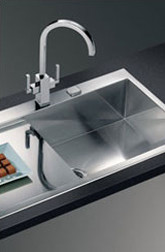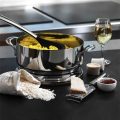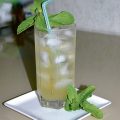By stainless steel is meanta metal alloy half composed of iron and 10.5% or more of chromium. Due to the high reflectivity of this alloy has a beautiful shine. The term "stainless" is not entirely correct, it would be better to call this alloy highly resistant to rust. Stainless steel cookware What are the benefits of stainless steel as a material for kitchen utensils?
Stainless steel cookware What are the benefits of stainless steel as a material for kitchen utensils?
- Stainless steel is characterized by the most hygienic surface, which has no pores and cracks, where bacteria can accumulate, and is easily cleaned from any contamination.
- Stainless steel tableware has an attractive appearance and does not require special care. It does not rust and hardly gets old.
- Stainless steel does not affect the taste and color of food, as it does not interact with the acids contained in it.
- When used properly, stainless steel utensils last more than 100 years and are recyclable for recycling.
 Where does stainless steel get its properties?Iron, the main element of stainless steel, extracted from iron ore, is unstable in its pure form and is susceptible to corrosion (rust). Chromium in stainless steel prevents iron corrosion by slowing down the chemical reaction of iron with oxygen, which forms iron oxide (rust). The reaction of chromium with oxygen forms a hard, transparent layer of chromium oxide. Small mechanical damage to this film can be tightened if there is free access to oxygen. Liquids and bulk substances stored in stainless steel dishes for a long time block the access of oxygen to chromium, which can lead to corrosion. The same effect is produced on stainless steel. Increasing the amount of chromium in the alloy increases the resistance to corrosion. The addition of nickel and molybdenum also contributes to the rust resistance of the steel. Titanium, vanadium, copper and non-metals (carbon, nitrogen and silicon) are used to improve the structure of steel. High-carbon stainless steel contains at least 0.3% carbon. The higher the carbon content, the stronger the steel. The strength of the steel allows it to be used for knife blades. The carbon in the steel makes it easier to sharpen the blades and keep them sharp for a long time.
Where does stainless steel get its properties?Iron, the main element of stainless steel, extracted from iron ore, is unstable in its pure form and is susceptible to corrosion (rust). Chromium in stainless steel prevents iron corrosion by slowing down the chemical reaction of iron with oxygen, which forms iron oxide (rust). The reaction of chromium with oxygen forms a hard, transparent layer of chromium oxide. Small mechanical damage to this film can be tightened if there is free access to oxygen. Liquids and bulk substances stored in stainless steel dishes for a long time block the access of oxygen to chromium, which can lead to corrosion. The same effect is produced on stainless steel. Increasing the amount of chromium in the alloy increases the resistance to corrosion. The addition of nickel and molybdenum also contributes to the rust resistance of the steel. Titanium, vanadium, copper and non-metals (carbon, nitrogen and silicon) are used to improve the structure of steel. High-carbon stainless steel contains at least 0.3% carbon. The higher the carbon content, the stronger the steel. The strength of the steel allows it to be used for knife blades. The carbon in the steel makes it easier to sharpen the blades and keep them sharp for a long time. How does stainless steel affect health? Elements of stainless steel that can affect the human body are iron, chromium and nickel.
How does stainless steel affect health? Elements of stainless steel that can affect the human body are iron, chromium and nickel.
- Iron is a necessary element of a healthy diet.
- Chromium is useful for humans in small quantities, but even four meals a day, cooked in steel cookware, do not result in exceeding the permissible daily dose of chromium.
- Nickel is toxic in large quantities, but fromsteel dishes in the food get small amounts of this metal. People suffering from nickel allergies are better off not using stainless steel utensils.
What precautions are needed when using stainless steel utensils?
- To prevent overheating of the dishes, sheshould have a bottom made of heat dissipating material, for example copper or aluminum. These metals have good thermal conductivity and allow cooking over low heat and without frequent stirring.
- Do not store food or liquids in stainless steel utensils.
- To keep stainless steel surfaces smooth, do not use abrasive detergents.
- If the lid is not removed from the cooled pan, heat it and unscrew the lid.
- Do not leave empty dishes on fire. If this happens, let it cool down by yourself.
 How to clean stainless steel dishes?
How to clean stainless steel dishes?
- To remove manufacturer and seller stickers, moisten them with warm water and remove with a plastic object. Glue can be removed with an alcohol-based solvent or citrus juice.
- Before first use, rinse the dishes in warm soapy water and dry thoroughly. It is not recommended to use a dishwasher for stainless steel dishes.
- White precipitate from hard water can be removed by boiling water with vinegar in a saucepan. To prevent limescale, add salt to food only after boiling water in a saucepan.
- To remove traces of burnt food, fill the pan with hot soapy water and boil for 5-10 minutes, then remove the contamination with a sponge.
- If the instructions for stainless steel utensils indicate that it can be washed in a dishwasher, use the pre-soak mode.
- Remove leaks and traces of “runaway” milk from the outer surface of the dish before the next use.
- If there are scratches on the surface of the dish, replace the detergent with a softer one.
- Do not use products containing chlorine and ammonia.
- Stainless steel knives better wash immediately afteruse, avoiding drying of food residue on the blade. That is why professional chefs always have a clean towel behind the belt. Wipe the knife, starting with the handle.
 How is stainless steel classified?
How is stainless steel classified?
- Austenitic steel is an alloy of chromium (16-26%),nickel and iron with a small amount of carbon. Nickel ensures the corrosion resistance of such steel. This alloy is hardened using low and high temperatures. It does not possess magnetic properties. The most commonly used alloy is No. 304 or 18/8, which includes 18% chromium and 8% nickel.
- Martensitic steel - an alloy of chromium and iron withchromium content from 10.5% to 17% and a low carbon content. The hardness of this alloy is achieved by rapid cooling in water or in oil. Along with hardness, this alloy is brittle and difficult to process. This steel has magnetic properties and is mainly used for the production of knives. A typical example of such steel is alloy No. 420.
- Ferritic steel is an alloy of chromium and iron with a chromium content of 17 to 27% and low carbon content. The alloy has magnetic properties. Alloy No. 430 is a typical sign of ferritic steel.
Made from austenitic and ferritic steelDuplex alloy and precipitation hardening steel used under extreme conditions are produced. How are different types of stainless steel used? Knives and other kitchen utensils are made of austenitic and ferritic steel. This steel is very durable, easy to clean, resistant to scratches and high temperatures. Austenitic steel is widely used in industrial food production. When choosing stainless dishes, you can save on baking molds and buy forms of low quality steel, but you should not save on pots and pans. Choose dishes with a bottom made of another metal that has a higher thermal conductivity than steel and prevents the bottom from overheating. Copper and aluminum usually play this role. Low-quality cutlery is made from ferritic steel No. 409 and 430. Martensitic steel No. 410 and 420, which provides sharpness of the blade for many years, is usually used for high-quality knives. Molybdenum and vanadium are added to the alloys for the highest quality knives. For spoons and forks use austenitic steel No. 304, which allows you to form complex elements.









